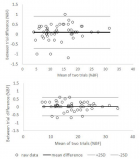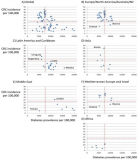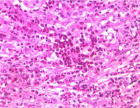Abstract
Research Article
Influence of elbow angle on the reliability and validity of bioelectrical impedance analysis
Robert W Pettitt, Jacob B Mehrhoff, David S Mandeville, Cherie D Pettitt and Steven Ross Murray
Published: 23 November, 2017 | Volume 2 - Issue 4 | Pages: 138-144
Hand-to-hand bioelectrical impedance (HH BIA) is a low-cost method to estimate percent body fat (%BF). The BIA method is consistently reliable, but questions on validity remain. We have observed anecdotally that elbow position can render consistently different measures of %BF while using HH BIA, thus leading to the question: Does elbow angle influence the validity of measures derived using HH BIA? The purpose of this study was to assess the effect of elbow position (i.e., IN=flexed to 90° versus OUT=fully extended) on the reliability of HH BIA on 44 male and 24 female healthy adults (age=21±2 yrs, BMI=23±3). An additional aim was to assess the validity of the HH BIA %BF on a subset of subjects (n=12) using air displacement plethysmography (BOD POD®) as the criterion measure. The IN position was ~4%BF lower than the OUT position for HH BIA (p=0.05, effect size=0.67). Measures of %BF for both trials for the IN [intraclass correlation coefficient (ICC)=0.99, coefficient of variation (CV)=2.99%] and OUT (ICC=0.99, CV=1.48%) conditions were highly reliable. On the subsample, the OUT (18.3±6.7 %BF) position exceeded both the IN (14.5±7.4 %BF) and the BOD POD® (16.1±7.8 %BF) measures (p<0.05); however, IN and BOD POD® measures of %BF did not differ (p=0.21). These findings support that HH BIA is a reliable measure at both elbow positions; however, %BF estimations vary considerably (~4%) with respect to the criterion measure depending on elbow position. The OUT position was found to overestimate criteria %BF. Further research may reveal an optimum elbow angle position for HH BIA estimates of %BF.
Read Full Article HTML DOI: 10.29328/journal.jsmt.1001019 Cite this Article Read Full Article PDF
Keywords:
Air displacement plethysmography; Anthropometrics; BIA; Body composition; Bodyfat
References
- Bosy-Westphal A, Muller MJ. Identification of skeletal muscle mass depletion across age and BMI groups in health and disease--there is need for a unified definition. Int J Obes (Lond). 2015; 39: 379-386. Ref.: https://goo.gl/Kja6XR
- Brooks GC, Blaha MJ, Blumenthal RS. Relation of C-reactive protein to abdominal adiposity. Am J Cardiol. 2010; 106: 56-61. Ref.: https://goo.gl/1BLif2
- Pou KM, Massaro JM, Hoffmann U, Vasan RS, Maurovich-Horvat P, et al. Visceral and subcutaneous adipose tissue volumes are cross-sectionally related to markers of inflammation and oxidative stress: the Framingham Heart Study. Circulation. 2007; 116: 1234-1241. Ref.: https://goo.gl/Fw6eMg
- Horton ES. Effects of lifestyle changes to reduce risks of diabetes and associated cardiovascular risks: results from large scale efficacy trials. Obesity (Silver Spring). 2009; 17: 43-48. Ref.: https://goo.gl/hfws6F
- Ackland TR, Lohman TG, Sundgot-Borgen J, Maughan RJ, Meyer NL, et al. Current status of body composition assessment in sport: review and position statement on behalf of the ad hoc research working group on body composition health and performance, under the auspices of the I.O.C. Medical Commission. Sports Med. 2012; 42: 227-249. Ref.: https://goo.gl/99HjFg
- Ballesteros-Pomar MD, Calleja-Fernandez A, Diez-Rodriguez R, Vidal-Casariego A, Blanco-Suarez MD, et al. Comparison of different body composition measurements in severely obese patients in the clinical setting. Nutr Hosp. 2012; 27: 1626-1630. Ref.: https://goo.gl/AaMuud
- Brodie DA, Stewart AD. Body composition measurement: a hierarchy of methods. J Pediatr Endocrinol Metab. 1999; 12: 801-816. Ref.: https://goo.gl/s54AgH
- Wagner DR, Heyward VH. Techniques of body composition assessment: a review of laboratory and field methods. Res Q Exerc Sport. 1999; 70: 135-149. Ref.: https://goo.gl/YACF4j
- Lu HK, Chiang LM, Chen YY, Chuang CL, Chen KT, et al. Hand-to-Hand Model for Bioelectrical Impedance Analysis to Estimate Fat Free Mass in a Healthy Population. Nutrients. 2016; 8. Ref.: https://goo.gl/9kz7F5
- Xiao J, Purcell SA, Prado CM, Gonzalez MC. Fat mass to fat-free mass ratio reference values from NHANES III using bioelectrical impedance analysis. Clinical nutrition (Edinburgh, Scotland). 2017. Ref.: https://goo.gl/GNDA9y
- Kyle UG, Bosaeus I, De Lorenzo AD, Deurenberg P, Elia M, et al. Bioelectrical impedance analysis--part I: review of principles and methods. Clin Nutr. 2004; 23: 1226-1243. Ref.: https://goo.gl/HtoUme
- Kyle UG, Bosaeus I, De Lorenzo AD, Deurenberg P, Elia M, et al. Bioelectrical impedance analysis-part II: utilization in clinical practice. Clin Nutr. 2004; 23: 1430-1453.Ref.: https://goo.gl/4rGzKU
- Aandstad A, Holtberget K, Hageberg R, Holme I, Anderssen SA. Validity and reliability of bioelectrical impedance analysis and skinfold thickness in predicting body fat in military personnel. Military medicine. 2014; 179: 208-217. Ref.: https://goo.gl/5PpZpm
- Stewart SP, Bramley PN, Heighton R, Green JH, Horsman A, et al. Estimation of body composition from bioelectrical impedance of body segments: comparison with dual-energy X-ray absorptiometry. Br J Nutr. 1993; 69: 645-655. Ref.: https://goo.gl/PBxETp
- Hsueh-Kuan L, Chiang L, Chen Y, Chuang C, Chen K, et al. Hand-to-hand model bioelectric impedance analysis to estimate fat free mass in a health population. Nutrients. 2016; 8: 654. Ref.: https://goo.gl/oUMAUm
- De Lorenzo A, Bertini I, Iacopino L, Pagliato E, Testolin C, et al. Body composition measurement in highly trained male athletes. A comparison of three methods. J Sports Med Phys Fitness. 2000; 40: 178-183. Ref.: https://goo.gl/Ep66Yp
- Lazzer S, Bedogni G, Agosti F, De Col A, Mornati D, et al. Comparison of dual-energy X-ray absorptiometry, air displacement plethysmography and bioelectrical impedance analysis for the assessment of body composition in severely obese Caucasian children and adolescents. Br J Nutr. 2008; 100: 918-924. Ref.: https://goo.gl/UTaCaM
- Turner AA, Bouffard M, Lukaski HC. Examination of bioelectical impedance errors using generalizability theory. Sports Med, Train Rehab. 1996; 7: 87-103. Ref.: https://goo.gl/tDzhsL
- Peeters MW, Claessens AL. Effect of different swim caps on the assessment of body volume and percentage body fat by air displacement plethysmography. J Sports Sci. 2011; 29: 191-196. Ref.: https://goo.gl/shTJVt
- Hopkins WG. Measures of reliability in sports medicine and science. Sports Med. 2000; 30: 1-15. Ref.: https://goo.gl/kqafAP
- Bland JM, Altman DG. Statistical methods for assessing agreement between two methods of clinical measurement. Lancet. 1986; 1: 307-310. Ref.: https://goo.gl/8KF5kh
- Lukaski HC, Siders WA. Validity and accuracy of regional bioelectrical impedance devices to determine whole-body fatness. Nutrition. 2003; 19: 851-857. Ref.: https://goo.gl/F22DPn
- Vicente-Rodriguez G, Rey-Lopez JP, Mesana MI, Poortvliet E, Ortega FB, et al. Reliability and intermethod agreement for body fat assessment among two field and two laboratory methods in adolescents. Obesity (Silver Spring). 2012; 20: 221-228. Ref.: https://goo.gl/Pz47dw
- Fogelholm M, van Marken Lichtenbelt W. Comparison of body composition methods: a literature analysis. Eur J Clin Nutr. 1997; 51: 495-503. Ref.: https://goo.gl/rAJ8aZ
- McCullagh WA, Ward LC. Assessing limb movement using real-time bioimpedance recording (abstract). 2003 Australian Conference of Science and Medicine in Sport; Canberra: 2003 Australian Conference of Science and Medicine in Sport. 2003. Ref.: https://goo.gl/xBxFKF
- McCullagh WA, Ward LC. Assessing limb movement by electroimpedancemyography. International Conference on Electrical Bioimpedance & Electrical Impedance Tomography; Gdansk, Poland: ICEBI XII - EIT V. 2004; 291-294. Ref.: https://goo.gl/tqzo6v
Figures:

Figure 1

Figure 2

Figure 3
Similar Articles
-
Joint Functional Screening for Older Adults: Clinical Prevention of Accidental FallBalwant S Bains*. Joint Functional Screening for Older Adults: Clinical Prevention of Accidental Fall. . 2017 doi: 10.29328/journal.jsmt.1001013; 2: 091-094
-
Influence of elbow angle on the reliability and validity of bioelectrical impedance analysisRobert W Pettitt,Jacob B Mehrhoff,David S Mandeville,Cherie D Pettitt,Steven Ross Murray. Influence of elbow angle on the reliability and validity of bioelectrical impedance analysis. . 2017 doi: 10.29328/journal.jsmt.1001019; 2: 138-144
-
The body composition analysis: Differences between students and the trend of their changeRatko Pavlović*,Zoran Radić,Irina Juhas,Mensur Vrcić. The body composition analysis: Differences between students and the trend of their change. . 2018 doi: 10.29328/journal.jsmt.1001025; 3: 036-042
-
Anthropometric characteristics and somatotype of professional soccer players by positionCavia MM*,Moreno A,Fernández-Trabanco B,Carrillo C,Alonso-Torre SR. Anthropometric characteristics and somatotype of professional soccer players by position. . 2019 doi: 10.29328/journal.jsmt.1001047; 4: 073-080
-
The Effect of Mat Pilates Exercise Program on Body Mass Index and Body Composition in Non-Physically Active Working Iraqi WomenSanaa Ali Ahmed Alrashid*. The Effect of Mat Pilates Exercise Program on Body Mass Index and Body Composition in Non-Physically Active Working Iraqi Women. . 2023 doi: 10.29328/journal.jsmt.1001073; 8:
Recently Viewed
-
Environmental Factors Affecting the Concentration of DNA in Blood and Saliva Stains: A ReviewDivya Khorwal*, GK Mathur, Umema Ahmed, SS Daga. Environmental Factors Affecting the Concentration of DNA in Blood and Saliva Stains: A Review. J Forensic Sci Res. 2024: doi: 10.29328/journal.jfsr.1001057; 8: 009-015
-
Markov Chains of Molecular Processes of Biochemical MaterialsOrchidea Maria Lecian*. Markov Chains of Molecular Processes of Biochemical Materials. Int J Phys Res Appl. 2024: doi: 10.29328/journal.ijpra.1001076; 7: 001-005
-
Generation of Curved Spacetime in Quantum FieldSarfraj Khan*. Generation of Curved Spacetime in Quantum Field. Int J Phys Res Appl. 2024: doi: 10.29328/journal.ijpra.1001077; 7: 006-009
-
Optimizing Milk Safety: Applying Nuclear Techniques in X-ray Fluorescence Spectroscopy for Heavy Metal Quantification in Powdered Milk Consumed in SenegalPapa Macoumba Faye*, Djicknack Dione, Oumar Ndiaye, Moussa Hamady SY, Nogaye Ndiaye, Alassane Traore, Ababacar Sadikhe Ndao. Optimizing Milk Safety: Applying Nuclear Techniques in X-ray Fluorescence Spectroscopy for Heavy Metal Quantification in Powdered Milk Consumed in Senegal. Int J Phys Res Appl. 2024: doi: 10.29328/journal.ijpra.1001078; 7: 010-015
-
Thermoelectric Materials Based on Lead Telluride and Prospects for their Practical ApplicationYuriy Pavlovskyy*, Nadiya Pavlovska. Thermoelectric Materials Based on Lead Telluride and Prospects for their Practical Application. Int J Phys Res Appl. 2024: doi: 10.29328/journal.ijpra.1001079; 7: 016-018
Most Viewed
-
Evaluation of Biostimulants Based on Recovered Protein Hydrolysates from Animal By-products as Plant Growth EnhancersH Pérez-Aguilar*, M Lacruz-Asaro, F Arán-Ais. Evaluation of Biostimulants Based on Recovered Protein Hydrolysates from Animal By-products as Plant Growth Enhancers. J Plant Sci Phytopathol. 2023 doi: 10.29328/journal.jpsp.1001104; 7: 042-047
-
Sinonasal Myxoma Extending into the Orbit in a 4-Year Old: A Case PresentationJulian A Purrinos*, Ramzi Younis. Sinonasal Myxoma Extending into the Orbit in a 4-Year Old: A Case Presentation. Arch Case Rep. 2024 doi: 10.29328/journal.acr.1001099; 8: 075-077
-
Feasibility study of magnetic sensing for detecting single-neuron action potentialsDenis Tonini,Kai Wu,Renata Saha,Jian-Ping Wang*. Feasibility study of magnetic sensing for detecting single-neuron action potentials. Ann Biomed Sci Eng. 2022 doi: 10.29328/journal.abse.1001018; 6: 019-029
-
Pediatric Dysgerminoma: Unveiling a Rare Ovarian TumorFaten Limaiem*, Khalil Saffar, Ahmed Halouani. Pediatric Dysgerminoma: Unveiling a Rare Ovarian Tumor. Arch Case Rep. 2024 doi: 10.29328/journal.acr.1001087; 8: 010-013
-
Physical activity can change the physiological and psychological circumstances during COVID-19 pandemic: A narrative reviewKhashayar Maroufi*. Physical activity can change the physiological and psychological circumstances during COVID-19 pandemic: A narrative review. J Sports Med Ther. 2021 doi: 10.29328/journal.jsmt.1001051; 6: 001-007

HSPI: We're glad you're here. Please click "create a new Query" if you are a new visitor to our website and need further information from us.
If you are already a member of our network and need to keep track of any developments regarding a question you have already submitted, click "take me to my Query."




















































































































































